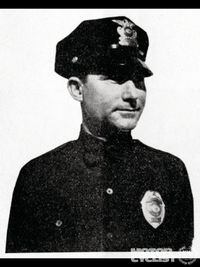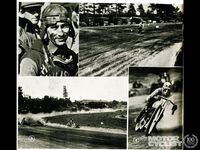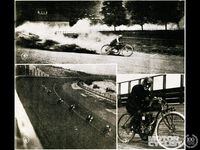From the January 1935 issue of Motorcyclist magazine
MUCH has been written about racing in America between the years of 1911 and 1929, but, to the best of my knowledge, there are still to be heralded some of the factors which operated behind the scenes.
As it may be of help and interest to present day riders, I would like to bring out if possible the elements of team work, the knowledge of mechanics, the versatility of the riders and the broadness of their training during the period I have mentioned.
In those days a rider, whether he be a National champion or just a member of a factory team, had to be ready to jump from a hard surfaced track to a soft one. He had to ride in dust so thick he could not see the rider ahead of him. One race might be one-lap on a mile and the next might be 300 miles. Following that he might be called upon to ride at Daytona Beach for a speed record.
Through it all he had to strive for team work, employing the tricks of the trade, not only to bring for himself a victory which was expected of him by fans and his factory alike, but he also had to conspire to bring through his team mates. It was like modern football. There was no place for straight sensational riding. In those days there was no demand for grandstanding. You were expected to fit into a general program, and you were trained to do it on dirt, sand or boards.
Training always has to have a starting point and mine started with the fastest ride I ever had in my life; not in terms of the stop watch, but in terms of my own sensations. Lee Humiston had just run the one-mile in 36 seconds (100 m.p.h.) and he had also turned 100 miles in 68 minutes upon the old board track at Playa del Rey or what some called the Venice Boards.
Indian was in hopes of recovering the record and accordingly Chas Balky riding a factory big base, eight valve was working to get it back. He was doing his work at the Indian agency in Los Angeles, C. Will Risdon’s place. I was working to develop an open port side valve dirt track job in connection with local events. It happened that one day I landed on the boards together with Balky, neither of us paying any attention to the other, and each trying to find bugs in his respective equipment.
Balky started out just as I did for a trial. Although my job was not capable of as much as his factory equipment, by reason of our starting together I happened to get pace on him and in consequence stayed with him for a few laps, the fastest of which clocked 39 seconds. Balky looked around under his arm and saw me hanging on so he put into use his unusual ability to ride the bottom board. I couldn’t stay on the bottom board but I didn’t lose pace. Before long we both came in and stopped.
After changing plugs Balky came over and asked if I had ever ridden a big base, eight valve. I told him no, and that my fastest lap had been the one we just turned. He said he would like to listen to his job and asked if I would like to take it around. Of course I said I would. He told me how to handle it and I took off to warm up and turned 37 4/5 seconds. That lap did things to me. In a sense it was the fastest I ever turned. The surprises I experienced as this motor responded to my every wish were so great that I never again received quite the same thrill. It was my initiation into speed and it clinched my determination to try for some real records.
As a result of that ride I was to work with Balky as mechanic and it might be opportune at this point to discuss the equipment we used in those days. Wheelbase was 56 inches, tires 28” x 2”, spring forks, direct drive from sprocket to wheel with a compensator on the rear wheel, wide open carburetor with no throttle control, open ports which were great for burning up your leggings and legs about half way between your ankles and knees, eight valves-four valves to a cylinder, and of course the big base or the crankcase of enormous size holding huge fly wheels which were very successful on board tracks. Incidentally in those days we had steel pistons which rang like bells and the piston pin was held in place by a boss which came down from the roof of the piston head, it not being anchored in the side of the piston.
The crowning achievement of my experience with Balky came one day when I was trying out a job on the Del Rey boards. A fire had consumed one portion of the track. This had been rebuilt for a width of seven feet. I had worked up to a speed of 96 m.p.h. and was dividing my attention between the noises of my mount and the problem of staying on the seven narrow feet through the burned portion when something happened. It seemed at the time like the whole world had suddenly been blotted out. Actually I had hit a sea gull, taking him full in my face. Luckily it did not knock me out, but the gull was not so fortunate. I never saw a sea gull cover so much territory before or since. I was covered with sea gull-and more sea gull.
Any guy who could take sea gulls on the nose like that was supposed to be good, so the factory entrusted me with an eight valve of my own to use in coast events. It was No. 48 and was destined in one way and another to become fairly well known to the fans in the West Coast territory.
Along about ‘16 we changed this motor over to closed port barrels. This developed to be an improvement as it made all the Indians run better and with less heat. Before this development could be carried far the war came along and by ‘17 many of the racers, including myself, found ourselves in France riding against time with shells and trying to dodge shell holes in the dark. This is a story in itself, so we will skip it, coming back to this country in the latter part of ‘19.
Perhaps receiving an entry blank in Coblenz, Germany, for a 200-mile event at Ascot on the same day the event was to run at Ascot speeded my return. There was an odd feature about Ascot. There you rode fast, and straight, in order to stay up. At most tracks you rode and slid so as to make time on the turns. Reviewing the peculiarities made me homesick, especially when later I heard that my old friend Ralph Hepburn had taken the event.
Upon my arrival in the U.S. I was given a place on the Harley-Davidson team, my first participation in an event being on Ascot late in the year. Burns had left the Harley-Davidson team, going with Indian, and I was selected to fill in.
At this point it might be well to describe the team as it was at that time.
















/cloudfront-us-east-1.images.arcpublishing.com/octane/VZZXJQ6U3FESFPZCBVXKFSUG4A.jpg)
/cloudfront-us-east-1.images.arcpublishing.com/octane/QCZEPHQAMRHZPLHTDJBIJVWL3M.jpg)
/cloudfront-us-east-1.images.arcpublishing.com/octane/HXOUJXQWA5HBHGRO3EMJIGFMVI.jpg)

/cloudfront-us-east-1.images.arcpublishing.com/octane/3TIWWRV4JBBOLDVGRYECVVTA7Y.jpg)
/cloudfront-us-east-1.images.arcpublishing.com/octane/KIX5O23D5NAIBGFXBN3327DKZU.jpg)
/cloudfront-us-east-1.images.arcpublishing.com/octane/7GJYDUIPXRGMTMQKN6ONYOLBOU.jpg)
/cloudfront-us-east-1.images.arcpublishing.com/octane/MUQLOVLL2ZDGFH25ILABNBXKTI.jpg)
/cloudfront-us-east-1.images.arcpublishing.com/octane/TNOU5DNE2BC57MFPMGN2EIDXAM.jpg)
/cloudfront-us-east-1.images.arcpublishing.com/octane/GTCXACQGJ5HAPDTGWUQKDEH44E.jpg)
/cloudfront-us-east-1.images.arcpublishing.com/octane/S35YGSEMEZB4BLTDJTSZPF4GLA.jpg)
/cloudfront-us-east-1.images.arcpublishing.com/octane/5UOT6HPX2JFMRJAX6EH45AR4MQ.jpg)
/cloudfront-us-east-1.images.arcpublishing.com/octane/OKWOJWAKP5EP3OACCRRWPCIX2Q.jpg)
/cloudfront-us-east-1.images.arcpublishing.com/octane/2WF3SCE3NFBQXLDNJM7KMXA45E.jpg)
/cloudfront-us-east-1.images.arcpublishing.com/octane/G4MG6OUCJNBSHIS2MVVOTPX65E.jpg)
/cloudfront-us-east-1.images.arcpublishing.com/octane/IIGGWFOTOJGB7DB6DGBXCCMTDY.jpg)
/cloudfront-us-east-1.images.arcpublishing.com/octane/QSTCM6AVEZA5JJBUXNIQ3DSOF4.jpg)
/cloudfront-us-east-1.images.arcpublishing.com/octane/U4I7G625B5DMLF2DVIJDFZVV6M.jpg)
/cloudfront-us-east-1.images.arcpublishing.com/octane/B6XD6LS6IVCQPIU6HXDJSM3FHY.jpg)
/cloudfront-us-east-1.images.arcpublishing.com/octane/ICL63FEDDRDTTMINYICCEYGMDA.jpg)
/cloudfront-us-east-1.images.arcpublishing.com/octane/FCGZHQXRBZFLBAPC5SDIQLVF4I.jpg)
/cloudfront-us-east-1.images.arcpublishing.com/octane/WNOB6LDOIFFHJKPSVIWDYUGOPM.jpg)

/cloudfront-us-east-1.images.arcpublishing.com/octane/X33NU3E525ECRHXLNUJN2FTRKI.jpg)